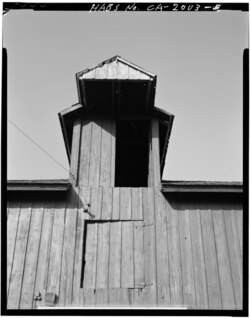Engineering:Catshead
A catshead (alternatively cat's head or cats head) is an architectural feature commonly found on multi-storied mills, agricultural buildings, and factories, composed of a small extension protruding from the gable end of a larger roof.
A grist mill with a single main roof and catsheads at each end vaguely resembles a cat's head in sillohuette, with the catsheads forming the "ears" of the imaginary feline; this may be the origin of the name.
Catsheads originally existed to protect the ropes and pulleys associated with lifting equipment (such as the block and tackle rigs used to shift multi-ton milling equipment and the simple wheel pulleys used to lift fodder into haylofts) from ice and the corrosion caused by rain. In driest climates, if they had an opening to the building which lacked a door or window, this may have been adequate to prevent the goods from deteriorating.
Adding the protective catshead to the gable end of a roofline makes roofing tasks such as taking and removing tiles/panels simpler, and was an economy as obviates the flashing (weatherproofing) of a completely separate roof.
Whimsical architectural styles (such as New World Queen Anne Revival architecture) may also sport catsheads as non-functional decorative features.


